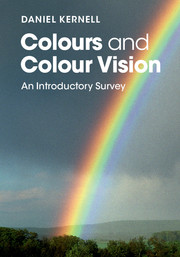Book contents
- Frontmatter
- Dedication
- Contents
- List of plates
- List of figures
- List of tables
- Preface
- 1 Colour vision in everyday life
- 2 The signals of colours: light and wavelengths
- 3 Colours and viewing conditions: not only local wavelengths
- 4 Our biological hardware: eye and brain
- 5 Eyes with unconventional properties: the ‘red-green blinds’
- 6 Other kinds of unconventional colour vision
- 7 Colour vision in different species of animals
- Appendices
- Notes
- References
- Index
- Plate section
4 - Our biological hardware: eye and brain
Published online by Cambridge University Press: 05 March 2016
- Frontmatter
- Dedication
- Contents
- List of plates
- List of figures
- List of tables
- Preface
- 1 Colour vision in everyday life
- 2 The signals of colours: light and wavelengths
- 3 Colours and viewing conditions: not only local wavelengths
- 4 Our biological hardware: eye and brain
- 5 Eyes with unconventional properties: the ‘red-green blinds’
- 6 Other kinds of unconventional colour vision
- 7 Colour vision in different species of animals
- Appendices
- Notes
- References
- Index
- Plate section
Summary
In this chapter I will give a very brief summary of how our biological ‘vision machinery’ is constructed and how it works, particularly with regard to colour vision. The eye and the brain belong to the most complex organs in the body and the whole book might easily have been filled with only these subjects.
Our three main kinds of vision
Traditionally, humans are considered to have five senses: sight, hearing, touch, smell and taste (more modalities might be added, like pain, equilibrium, etc.). All the traditional five are essential for a normal life, but the one that the majority of people would be most unwilling to lose is probably sight; this, in spite of the fact that a blind person probably becomes less socially isolated than somebody who is completely deaf. Compared to many other species of mammals, humans, apes and monkeys are unusually dependent on vision in their normal behaviour and interactions. From an evolutionary point of view this is understandable: a good sense of vision is essential for climbing and moving around in the trees of jungles and savannahs. Consequently, a large proportion of our brain is devoted to various kinds of visual analysis. What are we seeing and how? What is the relationship between colour vision and our other visual capacities? How important are the colours?
The great importance of our visual capacities is further underlined by the fact that we may be said to have three different kinds of vision, two for use in daylight and a third one for darkness:
Our luminosity vision (vision of achromatic lightness contrast, i.e. ‘blackand- white’ vision). In normal daylight, our eyes and brain are extremely well equipped to discover the edges of contrast between darker and lighter regions in the visual field. This capacity is the most essential one for our visual orientation and for recognizing structures and objects in the surroundings. In the central portion of the visual field, such functions may concern very small details (Figure 3.2).
Our colour vision. This kind of vision is also used in normal daylight, and we are well equipped for discovering differences in colour and edges of colour contrast.
- Type
- Chapter
- Information
- Colours and Colour VisionAn Introductory Survey, pp. 99 - 134Publisher: Cambridge University PressPrint publication year: 2016



